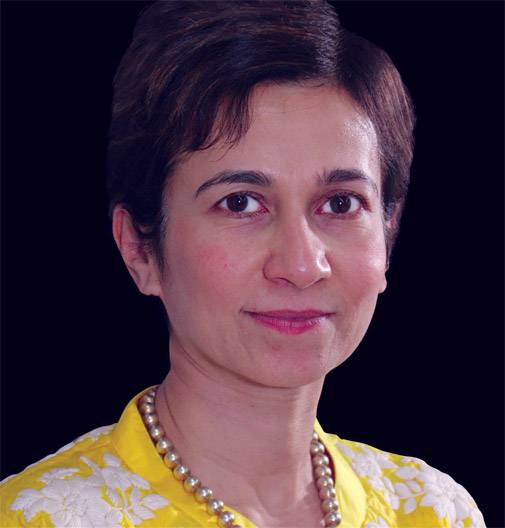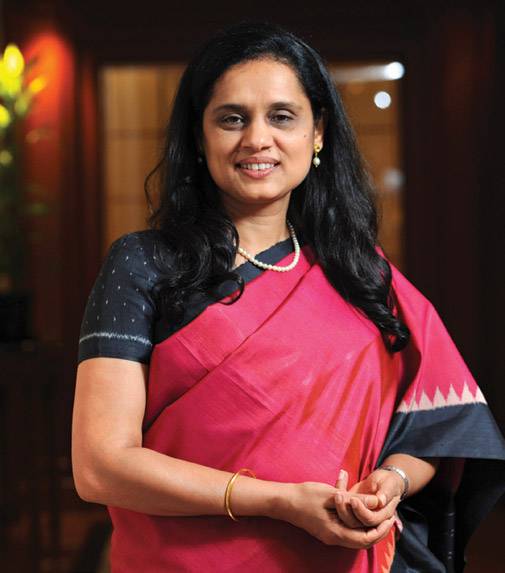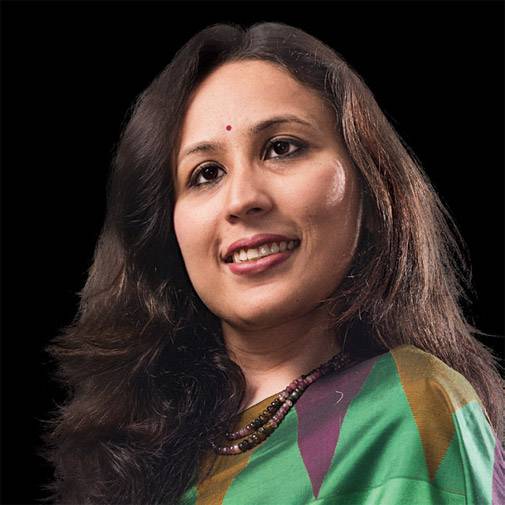Man ideal world, the proverbial glass ceiling no longer hinders the women at work, but the reality remains otherwise. “Women are still hugely under-represented in the mutual fund industry,” said HDFC Chairman Deepak Parekh while speaking at the 2018 summit of the Association of Mutual Fund of India. “They tend to be better savers, and it is a pool that asset management companies (AMCs) need to tap further. A more inclusive and participative style will reap benefits for all in the future.”
Parekh seems to have hit the nail on the head. When it comes to financial services, there are few women in board positions or corner offices barring a couple of key areas such as banking and investment banking. Sitting in the audience was Radhika Gupta, Chief Executive of Edelweiss AMC, who could not agree more. The lone CEO in India’s `25-lakh crore mutual fund industry, Gupta, too, rues the current scenario. “The diversity conversation has not come to us (AMCs) yet,” she says.
It is not entirely bleak out there as banks have witnessed a higher ratio of women workers and many of them have made it to the top. But the needle is moving slowly in areas such as AMC, private equity, securities, insurance and non-banking finance companies (NBFCs). Besides Gupta, other noted leaders include Vaishali Kasture, Managing Director and Country Head, Experian India – a credit information firm; Shilpa Kumar, Head, ICICI Securities; and Rajashree Nambiar, CEO, Fullerton India – an NBFC. These women at the top would probably encourage younger professionals to make a career in new and upcoming segments of financial services, but it will not be a cakewalk. “It is a journey,” says a woman working at a public sector bank (PSB). “These new segments have come up only in the past two decades. You will gradually see women in other financial services as well.”
Women’s career prospects in finance started to look up when they began to join retail banking in the ’70s and the ’80s. But the progress of gender parity across the industry was still rare. Kasture recalls how things were when she joined Citibank in the early ’90s. “I was the only woman in a batch of 25 men in the corporate banking department,” she says. In those days, not many women preferred corporate banking as a career choice. Even PSBs took decades before woman leaders came to the fore. Ranjana Kumar was the first woman to head a PSB in 2000, when she was appointed Chairperson and Managing Director of Indian Bank and resuscitated the organisation. Homai Ardeshir Daruwalla became CMD of Central Bank in 2005, and Arundhati Bhattacharya helmed the State Bank of India, the country’s largest lender, during 2013-17. The Reserve Bank of India has also seen several women rising to the level of deputy governors. Overall, these C-suite success stories are some of the finest examples of women’s capabilities even though more men get promoted at significantly higher rates than women.

According to industry experts, women are a good fit for the banking business as they bring in certain natural, and indispensable qualities – trust, emotional quotient and a savings mindset. In fact, some private bankers in India actively encouraged gender diversity to benefit from these attributes. It was further adopted and pushed as their global peers clearly gained from similar policies. For instance, ICICI Bank, under the visionary leadership of Narayanan Vaghul and K.V. Kamath, initiated women-friendly policies across the organisation and also considered them for challenging or revenue-earning assignments.
Renuka Ramnath (Founder, MD and CEO of Multiples Alternate Asset Management) got all the support when she headed the company’s private equity arm, the largest in India. Similarly, Shikha Sharma (she has led Axis Bank since 2009, but will demit her post by the end of this year) built the life insurance business nearly from the scratch while Vishakha Mulye, currently an executive director of ICICI Bank, was on the board of ICICI Lombard General Insurance and became MD and CEO of ICICI Venture Funds in 2009. Another veteran Madhabi Puri Buch also played a crucial role in setting up the broking arm of the bank and headed ICICI Securities way back in 2009. Shilpa Kumar came as CEO in 2016. “The ICICI Group may be a bit of an exception in the industry, but what has also worked for the professionals is their vast experience across segments,” says Kumar, commenting on the steady succession of women leaders.
The Group’s women-friendly policies have also contributed to the impressive statistics. For instance, it has a travel policy for women managers with young children aged below three. When these women travel outside the city for work, ICICI also bears the cost of children’s travel and stay. “This enables young managers to focus on their work without the emotional stress of staying away from their children,” the bank states. Two years ago, it came out with a work-from-home programme that can be availed up to a year. But such initiatives are few and far between in the up-and-coming financial services segments as the companies are still grappling with business issues. “These areas are relatively new with many small players, and it would take some time to set up these policies,” a woman working at a private equity firm says.

Decoding CEO Stuff
The lack of collaborative, women-friendly culture is not the only problem that is hindering career progression. The gender stereotype and its outcome are also responsible for the roadblocks. A look at the national and global companies tells us the story here – very few women in financial services are in the top job because they are not actively involved in revenue generation. “When it comes to profit, sales and marketing or negotiation, women are not preferred,” says another women professional, requesting anonymity. In contrast, most CEOs come from sales and marketing background or other revenue-generating divisions.
“The proportion of women in non-revenue-generating roles is certainly higher, but there is no difference in the way a person delivers in all kinds of roles,” points out Kumar of ICICI Securities. Kumar has women- heading technology and risk management functions. She has been in revenue-generating roles all along.
Nevertheless, unconscious bias might not be easy to stamp out. For example, AMCs employ several women fund managers, but very few women work in sales and marketing. “It is a broader capital market problem. Our origin as fund manager came from broking background, which has always been male-dominated,” reasons Gupta when confronted with the issue.
HR experts think it will be an evolutionary process. The AMCs with women fund managers are well placed to feed professionals to various segments such as private equity, distressed funds, alternative investment funds, venture capital and wealth management. “They have to take the risk and try placing women in these new areas,” says an HR veteran who does not want to be named.
Some also blame women workers for not going for the kill when it matters most. And unlike the successful few, many would not consider shifting focus or changing careers to learn new skills or tap better opportunities. A look at the career graphs of the women CEOs in the new sectors proves this point. Gupta, who started her career at McKinsey & Company, shifted to a hedge fund and later started an alternative AMC. Nambiar, too, switched from banking to NBFC. After working for Standard Chartered Bank for more than two decades, she accepted the top job at India Infoline Finance and later joined Fullerton India.
Being dynamic helps career progression, but it does not happen too frequently for a reason, says Kasture. “Women have the double job of managing home and office, and they are programmed to be risk-averse. It is not just an Indian problem.”

A Shrinking Pipeline
Players in the financial services space are often quick to dole out gender diversity data without highlighting the highly skewed ratio – a sizeable representation at entry and junior levels that dangerously thins out in the middle and is rarely seen at the board level. It also means there are few role models who can handhold and inspire. “A lot of focus is on the CEOs, but we need a better pipeline of women professionals. The participation of women should be more broad-based,” says Gupta. According to Kasture, the real metrics should be the number of women in the middle and in managerial and revenue-generating roles.
Ankit Bansal, Founder and CEO, Sapphire Human Solutions, lists the reasons behind a shrinking pipeline. “There are dropouts at every stage right after college and B-schools. Women get married, the children arrive, and there’s more responsibility as the kids grow up. So, the pipeline shrinks at every level. It is a fundamental problem, not something that could be fixed in the next five years.” Women also feel demotivated if they lose out to male peers after taking maternity breaks.
A deep dive into gender diversity conveys one thing for sure – that there is no easy template to follow. But it is crucial for companies as diverse workplaces could make us wealthier and the economies stronger. In a recent study, economists from Stanford and the University of Chicago have found that 24 per cent of the US economic growth between 1960 and 2010 came from giving women and minorities access to high-skill jobs. Researchers also claim that the GDP per person could further increase by 15-20 per cent subject to equal educational access and a total absence of discrimination. When Parekh said in his closing remarks that AMCs risk falling behind the curve if they do not begin to focus strongly on diversity, he was very close to the bigger scenario.
The process has started in the financial services space, albeit slowly. Shweta Jalan, MD, Advent India PE Advisors – a private equity firm, says that the company is working on a diversity initiative and members are being included from across the geographies. The idea is to find out what the company can do to get more women into the private equity. It begins with worklife balance, a right recruitment framework and other essentials. Besides individual companies, regulations could also play a significant role to promote gender parity. The Securities and Exchange Board of India, the country’s capital markets regulator, is already insisting on having at least one woman director on the board of each top company. “If that happens, at least the conversation will start at the board level,” says a young hopeful, keen to continue her journey to the top.
